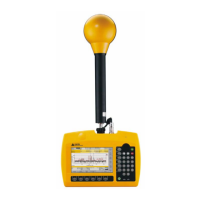18 Annex A
Narda SRM-3006 211
Advantages of this method
• Good measurement reproducibility
• Allows spatial averaging of emissions (required by some standards)
• Local maxima can be located using a few measurement points.
Useful application
• Exact measurement of a defined space with the aid of a tripod
• Spatial averaging of emissions desirable (required by some standards)
• Location of local maxima
Disadvantages of this method
• The signal to be measured must remain constant for the measurement
time to record the three spatial components
• Time-consuming: the already quite complex task of measuring the
defined measurement volume must be repeated at different points in the
room for the entire room to be surveyed.
• Relatively high degree of disruption for the affected rooms: no conducting
objects or persons should move within the defined measurement volume
during the measurement. A minimum distance between the antenna and
interfering objects or elements (e.g. furniture, walls) must be maintained
to prevent any adverse effect on the receiving characteristics of the
antenna.
Limitations
• Maximum values cannot be determined quickly because a large number
of measurement points must be recorded
• The signal does not remain constant over the entire period of the
measurement
• Searching for maximum values in locations where there is low tolerance
to disruption (e.g. offices)
• Searching for maximum values in locations where a high degree of
mobility is required (e.g. platforms, roofs)
• Locations where a tripod cannot be used (e.g. platforms, roofs)

